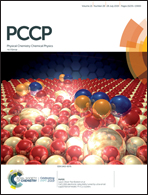Tuning the dielectric and energy storage properties of polystyrene-based polymer dielectric by manipulating dipoles and their polarizing behavior†
Abstract
Polymer dielectrics with high energy density can be realized in high-k polymers, but undesirable energy loss always occurs, especially at high electric field and elevated temperature application. By systematically comparing the dielectric and energy storage properties of poly(styrene-methyl methacrylate)s (P(St–MMA)s) with PSt and PMMA homopolymers, the positive roles of the MMA units in the improvement of their dielectric and energy storage properties are well addressed. The best electric performance, including the largest Ue of 12.2 J cm−3, η of 92%, and Eb of 530 MV m−1 at ambient temperature, was obtained in the copolymer bearing 45 mol% MMA. Considering the different types of dipoles and the generated intermolecular forces, the influence of MMA on the dielectric performances of the copolymers is well illustrated. Instead of permanent dipoles alone, the combination of isolated permanent dipoles together with induced dipoles may be promising for realizing high-k, high energy density and low loss. This conclusion helps to understand the dielectric performances of polymer dielectrics from an intermolecular force point of view and proposes a strategy for realizing high energy density but low loss under a high electric field in polymer dielectrics.



 Please wait while we load your content...
Please wait while we load your content...